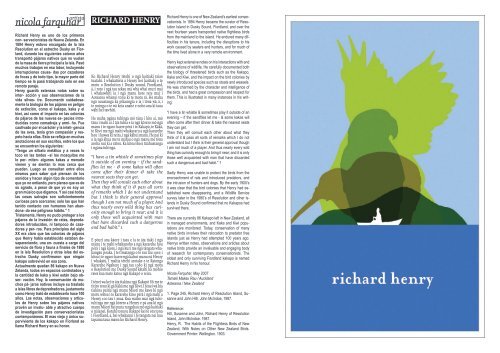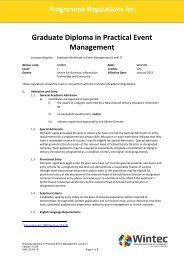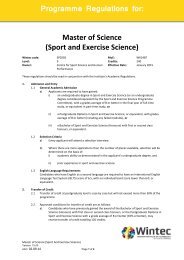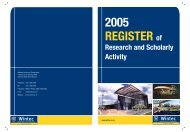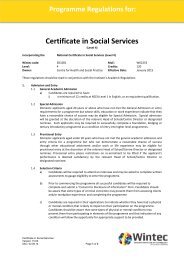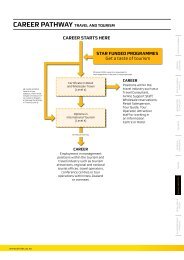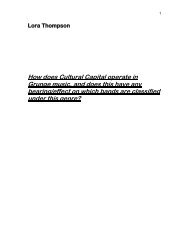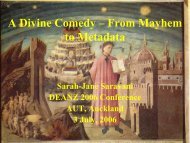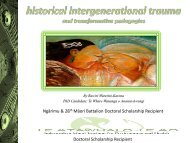aotearoa liberators - Wintec Research Archive
aotearoa liberators - Wintec Research Archive
aotearoa liberators - Wintec Research Archive
- No tags were found...
You also want an ePaper? Increase the reach of your titles
YUMPU automatically turns print PDFs into web optimized ePapers that Google loves.
artistanicola farquharRichard Henry es uno de los primeroscon- servacionistas de Nueva Zelanda. En1894 Henry estuvo encargado de la IslaResolution en el estrecho Dusky en Fiorland,durante los siguientes catorce añostransportó pájaros nativos que no vuelande la masa de tierra principal a la isla. Pasómuchos trabajos en esa labor, incluyendointerrupciones causa- das por cazadoresde focas y de todo tipo, la mayor parte deltiempo se la pasó trabajando solo en eseremoto paraje.Henry guardó extensas notas sobre suinter- acción y sus observaciones de lavida silves- tre. Documentó cuidadosamentela biología de los pájaros en peligrode extinción, como el kakapo, kaka y elkiwi, así como el impacto en las coloniasde pájaros de las nuevas es- pecies introducidascomo comadreja y armi- ño. Fuecautivado por el carácter y la inteli- genciade las aves, tenia gran compasión y respetohacia ellas. Esto se refleja en muchasanotaciones en sus escritos, entre los quese encuentran los siguientes:“Tengo un silbato metálico y a veces lotoco en las tardes –si los mosquitos melo per- miten- algunos kakas a menudovienen y se sientan lo mas cerca quepueden. Luego se consultan entre ellosmismos para saber qué piensan de lossonidos y hacen algún tipo de comentarioque yo no entiendo, pero pienso que es desu agrado, a pesar de que yo no soy ungran músico que digamos. Y así casi todaslas cosas salvajes son suficientementecuriosas para acercarse; solo las que hantenido contacto con humanos han abandona-do ese peligroso hábito.” 1Tristemente, Henry no pudo proteger a lospájaros de la invasión de ratas, depredadoresintroducidos, ni tampoco de cazadoresy per- ros. Para principios del sigloXX era claro que las colonias de pájarosque Henry había establecido estaban desapareciendo,una en- cuesta a cargo delservicio de flora y fauna a finales de 1880en la isla Resolution y otras islas del estrechoDusky confirmaron que ningúnkakapo sobrevivió en esa zona.Actualmente quedan 86 kakapo en NuevaZelanda, todos en espacios controlados yla cantidad de kaka y kiwi están bajo obser-vación. Hoy, la conservación de muchospá- jaros nativos incluye su trasladoa islas libres de depredradores, justamentecomo Henry trató de establecerlo hace 100años. Las notas, observaciones y artículosde Henry sobre los pájaros nativosprovén un invalu- able y atractivo cuerpode investigación para conservacionistascontemporáneos. El mas viejo y único supervivientede los kakapo en Fiorland sellama Richard Henry en su honor.RICHARD HENRYKo Richard Henry tētehi o ngā kaitiaki taiaotuatahi. I whakatūria a Henry hei kaitiaki o temotu o Resolution i Dusky sound, Fiordland,ā, i roto i ngā tau tekau mā whā whai muri maii whakawhiti ia i ngā manu kore rere mai iAotearoa whānui tonu ki te motu rā. He mahangā uauatanga ka pīkaungia e ia i tōna wā, ā, ite nuinga o te wā koia anahe e noho ana ki tauawāhi kei tawhiti.He maha ngāna tuhinga mō tāna i kite ai, mōtāna i mahi ai. I āta tuhia e ia ngā kōrero mō ngāmanu i te ngaro haere pērā i te Kakapō, te Kākā,te Kiwi me ngā mahi whakararu a ngā kararehehou i kawea ki reira, i ngā kāhui manu. He pai kia ia ngā āhua me te mātau o ngā manu me tōnaaroha nui ki a rātou. Ka kitea tēnei tūāhuatangai ngāna tuhinga.“I have a tin whistle & sometimes playit outside of an evening – if the sandflieslet me - & some kakas will oftencome after their dinner & take thenearest seats they can get.Then they will consult each other aboutwhat they think of it & pass all sortsof remarks which I do not understandbut I think is their general approvalthough I am not much of a player. Andthus nearly every wild thing has curiosityenough to bring it near; and it isonly those well acquainted with manthat have discarded such a dangerousand bad habit.” 1E pōuri ana kāore i taea e ia te āta tiaki i ngāmanu i te mahi whakanoho a ngā kararehe houpērā i ngā kiore, i ngā kurī me ngā tāngata whakangaupoaka. I te tīmatanga o te rau tau 1900 ikitea i te ngaro haere ngā kahui manu nā Henryi whakatū. I mahia tētehi arotake e te RatongaKararehe Ngahere i ngā tau 1980 ki ngā motuo Resolution me Dusky Sound kātahi ka mōhiorawa kua mate katoa ngā Kakapō o reira.I tēnei wa kei te āta tiakina ngā Kakapō 86 me tetitiro tonu ki gā Kākā me ngā Kiwi. I tēnei wā kiatiakina paitia ngā manu Māori me kawe ki ngāmotu wātea i te kararehe kino pērā i ngā mahi aHenry 100 tau i mua. Kua waiho mai ngā tuhituhingame ngā kōrero a Henry e pā ana ki ngāmanu Māori hei puna rangahau mō ngā kaitiakio nāianei. Kotahi tonu te Kakapō kei te ora tonui Fiordland, ā, hei whakanui i te tangata nei kuatapaina taua manu ko Richard Henry.Richard Henry is one of New Zealand’s earliest conservationists.In 1894 Henry became the curator of ResolutionIsland in Dusky Sound, Fiordland, and over thenext fourteen years transported native flightless birdsfrom the mainland to the island. He endured many difficultiesin his tenure, including the disruptions to hiswork caused by sealers and hunters, and for much ofthe time lived alone in a very remote environment.Henry kept extensive notes on his interactions with andobservations of wildlife. He carefully documented boththe biology of threatened birds such as the Kakapo,Kaka and Kiwi, and the impact on the bird colonies bynewly introduced species such as stoats and weasels.He was charmed by the character and intelligence ofthe birds, and had a great compassion and respect forthem. This is illustrated in many instances in his writing:“I have a tin whistle & sometimes play it outside of anevening – if the sandflies let me - & some kakas willoften come after their dinner & take the nearest seatsthey can get.Then they will consult each other about what theythink of it & pass all sorts of remarks which I do notunderstand but I think is their general approval thoughI am not much of a player. And thus nearly every wildthing has curiosity enough to bring it near; and it is onlythose well acquainted with man that have discardedsuch a dangerous and bad habit.” 1Sadly Henry was unable to protect the birds from theencroachment of rats and introduced predators, andthe intrusion of hunters and dogs. By the early 1900’sit was clear that the bird colonies that Henry had establishedwere disappearing, and a Wildlife Servicesurvey later in the 1980’s of Resolution and other islandsin Dusky Sound confirmed that no Kakapos hadsurvived there.There are currently 86 Kakapo left in New Zealand, allin managed environments, and Kaka and Kiwi populationsare monitored. Today, conservation of manynative birds involves their relocation to predator freeislands just as Henry had attempted 100 years ago.Henrys written notes, observations and articles aboutnative birds provide an invaluable and engaging bodyof research for contemporary conservationists. Theoldest and only surviving Fiordland kakapo is namedRichard Henry in his honour.Nicola Farquhar, May 2007Tamaki Makau Rau / AucklandAotearoa / New Zealand1. Page 245, Richard Henry of Resolution Island, Susanneand John Hilll. John McIndoe, 1987.Reference:Hill, Susanne and John, Richard Henry of ResolutionIsland, John McIndoe. 1987.Henry, R. The Habits of the Flightless Birds of NewZealand; With Notes on Other New Zealand Birds.Government Printer: Wellington. 1903.


